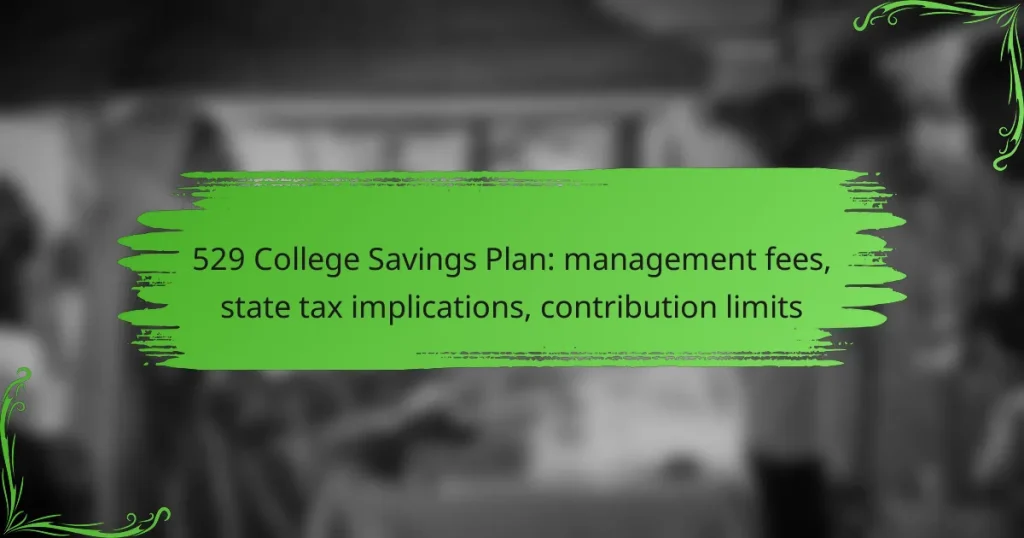The 529 College Savings Plan is a valuable tool for funding education, but it’s essential to understand its management fees, state tax implications, and contribution limits. Management fees typically range from 0.5% to 2% annually, which can affect your overall savings. Additionally, many states offer tax deductions or credits for contributions, enhancing the plan’s benefits. Contribution limits vary by state, allowing for substantial savings while adhering to federal guidelines.

What are the management fees for a 529 College Savings Plan in the UK?
Management fees for a 529 College Savings Plan in the UK typically range from 0.5% to 2% of assets annually. These fees can vary based on the investment options selected and the provider chosen, impacting overall savings for education.
Typical fee structures
Management fees for 529 College Savings Plans usually consist of an annual asset-based fee, which is a percentage of the total assets in the account. Some plans may also charge additional fees for specific investment options, such as actively managed funds, which can be higher than passive options.
In addition to management fees, there may be other costs involved, such as account maintenance fees or transaction fees for buying and selling investments. It’s essential to review the fee schedule provided by each plan to understand the total cost of participation.
Comparison of fees across providers
Fees can vary significantly among different 529 College Savings Plan providers. Some states offer plans with lower fees, while others may have higher costs due to additional services or investment options. Comparing plans can help identify the most cost-effective choice for your savings goals.
For example, a plan with a 0.5% management fee may save you more in the long run compared to one with a 2% fee, especially over many years of compounding growth. Utilize online comparison tools to assess the fees of various providers effectively.
Impact of fees on savings growth
Management fees can have a substantial impact on the growth of your 529 College Savings Plan. Even a small difference in fees can lead to significant variations in the amount available for education expenses when the time comes to withdraw funds.
For instance, a 1% higher fee could reduce your total savings by tens of thousands of pounds over a 20-year period, depending on your contributions and investment performance. Therefore, it is crucial to consider fees when selecting a plan to maximize your education savings.

How do state tax implications affect 529 College Savings Plans?
State tax implications can significantly influence the benefits of 529 College Savings Plans, as many states offer tax deductions or credits for contributions. Understanding these implications helps maximize savings and minimize tax liabilities.
Tax benefits for UK residents
UK residents do not have specific tax benefits related to 529 College Savings Plans, as these plans are primarily designed for U.S. taxpayers. However, UK residents investing in U.S. education savings may still benefit from the tax-free growth of investments within the plan.
It’s essential for UK residents to consult with a tax advisor to understand any potential tax obligations in both the U.S. and the UK when considering 529 plans.
State-specific tax deductions
Many U.S. states offer tax deductions or credits for contributions made to a 529 plan, which can reduce state taxable income. The specifics vary by state; for example, some states allow deductions up to a few thousand dollars per year, while others may not offer any tax benefits at all.
Before contributing, check your state’s regulations to determine the maximum allowable deduction and whether your contributions will qualify for any tax incentives.
Consequences of non-compliance
Failing to comply with state tax regulations regarding 529 plans can lead to penalties, including the loss of tax benefits or additional taxes on earnings. For instance, if contributions exceed state limits or if funds are used for non-qualified expenses, the state may impose taxes on the earnings.
To avoid these consequences, ensure that contributions align with state guidelines and that withdrawals are used solely for qualified educational expenses. Regularly review your plan to stay informed about any changes in state tax laws that may affect your 529 plan.

What are the contribution limits for 529 College Savings Plans?
Contribution limits for 529 College Savings Plans vary by state, but generally, they allow significant contributions to help save for education costs. Most states set annual and lifetime limits to encourage saving while adhering to federal guidelines.
Annual contribution limits
Annual contribution limits for 529 plans typically align with federal gift tax exclusions, which are around $17,000 per individual in 2023. This means that an individual can contribute up to this amount each year without incurring gift taxes. Couples can combine their contributions, allowing for a total of approximately $34,000 annually.
Lifetime contribution limits
Lifetime contribution limits for 529 plans can range from $200,000 to over $500,000, depending on the state. These limits are designed to cover the expected costs of higher education, including tuition, fees, and room and board. Once the account reaches the lifetime limit, no further contributions can be made, but the account can still grow through investment earnings.
Gift tax considerations
When contributing to a 529 plan, it’s essential to consider gift tax implications. Contributions exceeding the annual exclusion amount may require filing a gift tax return, although taxes may not be owed. Additionally, 529 plans allow for a special provision where individuals can contribute up to five times the annual exclusion in a single year, effectively front-loading contributions for the beneficiary’s future education expenses.

What criteria should I consider when choosing a 529 College Savings Plan?
When selecting a 529 College Savings Plan, consider factors such as provider reputation, investment options, management fees, and state tax implications. These elements can significantly impact your savings growth and overall experience.
Provider reputation
Choosing a reputable provider is crucial for the long-term success of your 529 plan. Look for established financial institutions with a history of strong performance and customer satisfaction. Research reviews and ratings from independent sources to gauge their reliability.
Additionally, check if the provider offers robust customer support and educational resources. A provider that is responsive to inquiries and provides clear information can enhance your experience and help you make informed decisions.
Investment options available
Evaluate the range of investment options offered by the 529 plan. Many plans provide a mix of age-based portfolios, which automatically adjust as your child approaches college age, and static investment options that remain unchanged. Consider your risk tolerance and investment goals when selecting the right mix.
Some plans may also offer unique investment strategies, such as socially responsible investing or specific asset classes. Review the historical performance of these options to ensure they align with your expectations for growth and risk management.

How can I maximize my 529 College Savings Plan benefits?
To maximize your 529 College Savings Plan benefits, focus on making regular contributions, selecting appropriate investment options, and understanding the tax implications. By strategically managing your contributions and investments, you can enhance your savings for educational expenses.
Strategies for effective contributions
Start by contributing the maximum allowable amount each year to take full advantage of tax benefits. For 2023, the annual contribution limit is typically around $15,000 per beneficiary without incurring gift tax implications. Consider setting up automatic contributions to ensure consistent funding.
Additionally, some states offer tax deductions or credits for contributions made to their own 529 plans. Research your state’s specific benefits to optimize your contributions. For example, if you live in New York, you can deduct up to $5,000 per year from your state taxable income.
Investment performance tracking
Regularly monitor the performance of your 529 plan investments to ensure they align with your savings goals. Most plans provide online tools and resources to track investment growth and assess risk levels. Aim for a diversified portfolio that balances growth potential with your time horizon until your child starts college.
Consider reviewing your investment strategy at least annually or when significant life changes occur. If your investments are underperforming, it may be wise to reallocate funds to more suitable options. Always keep an eye on management fees, as high fees can erode your savings over time.

What are the common pitfalls to avoid with 529 College Savings Plans?
Common pitfalls with 529 College Savings Plans include over-contributing beyond limits and overlooking management fees that can erode savings. Being aware of these issues can help maximize the benefits of your investment in education savings.
Over-contributing issues
Over-contributing to a 529 plan can lead to tax penalties and complications. Most states set contribution limits, often ranging from $300,000 to $500,000 per beneficiary, but exceeding these limits can trigger gift tax implications.
To avoid over-contributing, regularly review your contributions against your state’s limits and consider the total amount needed for future education expenses. It’s also wise to consult a financial advisor to align contributions with your educational savings goals.
Ignoring fee structures
Ignoring the fee structures associated with 529 plans can significantly impact your savings over time. Management fees, which can range from 0.5% to 1.5% annually, may seem small but can accumulate and reduce your overall returns.
When selecting a 529 plan, carefully compare the fees of different plans and consider the investment options available. Opt for plans with lower fees and solid performance histories to maximize your investment’s growth potential.

What are the future trends in 529 College Savings Plans?
Future trends in 529 College Savings Plans are focusing on more diverse investment options and potential changes in tax legislation that could affect contributions and withdrawals. These developments aim to enhance the flexibility and benefits of 529 plans for families saving for education.
Emerging investment options
As the landscape of 529 College Savings Plans evolves, new investment options are becoming available, including ESG (Environmental, Social, and Governance) funds and cryptocurrency-related investments. These options allow account holders to align their investments with personal values or explore innovative asset classes.
Families should consider the risk and return profiles of these emerging options. While traditional investments like mutual funds and ETFs remain popular, the introduction of alternative assets may offer higher growth potential but also comes with increased volatility.
Changes in tax legislation
Tax legislation affecting 529 College Savings Plans is subject to change, which can impact how contributions and withdrawals are treated. Recent discussions in Congress have focused on expanding tax benefits, such as allowing 529 funds to be used for K-12 education expenses or student loan repayments.
Families should stay informed about potential legislative changes that could enhance the tax advantages of 529 plans. Consulting a tax advisor can help navigate these developments and maximize the benefits of contributions, ensuring compliance with current regulations.


